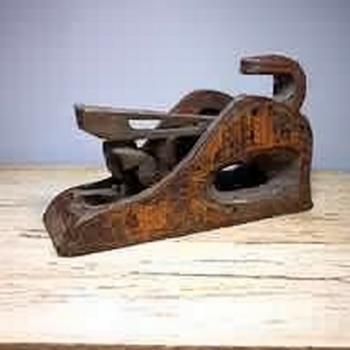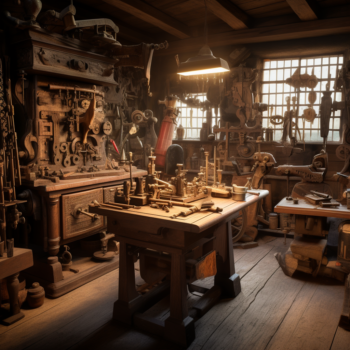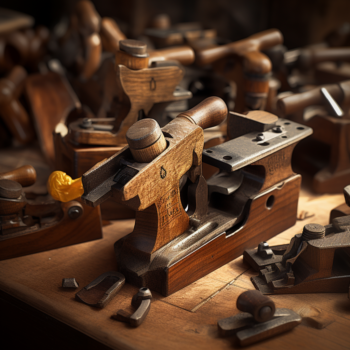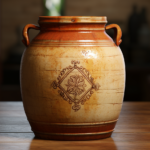Wooden Marvels: The Fascinating History of Wood Planes
Are you in possession of an antique woodworking tool that resembles a wood plane? Not sure about its value or if it’s a cheap reproduction? Expert appraisers from Appraisily can help you. They can aid you in antique wood planes identification.
Woodworking tools have been used for centuries. Their origins can be traced back to ancient times. Wood planes, a type of woodworking tool, were used to create smooth, uniform surfaces on wood. Archaeological findings suggest that early Egyptians and Romans used hand tools similar to wood planes for various woodworking tasks.
The Middle Ages saw European woodworkers use wooden planes with iron blades. These wood planes were entirely handcrafted and highly valued for their functionality in shaping wood.
In the 18th and 19th centuries production of wood planes increased massively. This increase was due to the Industrial Revolution. It led to standardized designs. Also, manufacturing these tools became more accessible to a broader range of woodworkers.
The modern era now sees the use of electric and power tools that have largely replaced hand wood planes. However, hand wood planes are still widely used by craftsmen and woodworking enthusiasts, especially those who appreciate the precision and control the tool offers.
Due to the resurgence of interest in traditional woodworking techniques, there is a renewed appreciation for hand wood planes. Antique enthusiasts and collectors are always on the lookout for unique wood planes especially those that have value and historical significance.
How to Identify Antique Wood Planes Like a Pro
To know the real worth of antique wood planes it is essential to first identify the old woodworking tool as an antique. Not all old-looking wood planes in the antique market can be termed as antique wood plane.
Cheap reproductions and even fake antique pieces have made their way into the antique market which is why one needs the expertise of professional appraisers to identify and determine the value of antiques. This is where an appraisal comes in. The process requires a combination of expertise, research, and attention to detail.
Antique wood planes hold significant historical and monetary value, making it essential for appraisers to have a comprehensive understanding of these tools and the factors that influence their worth. Let’s do an in-depth exploration and delve into the methods, considerations, and challenges that appraisers face when carrying out antique wood planes identification.
Historical Context and Research
A crucial aspect when appraising antique wood planes involves understanding their historical context. Appraisers need to research the specific time period, region, and craftsmanship styles associated with the plane in question. This is where the knowledge of famous plane makers, unique designs of wood planes, and innovations over different eras can come in handy. This helps appraisers accurately date and attribute the wood plane, laying the foundation for a precise appraisal.
Physical Examination
A meticulous physical examination of the wood plane is indispensable in assessing the condition and authenticity of an antique piece. Appraisers examine the overall structure, wood type, and look for any identifying marks or signatures on the wood plane. They pay close attention to the plane’s body, sole, handle, wedge, and blade. Signs of wear and repairs can provide valuable clues about the plane’s age and usage history. Originality is highly prized in antique wood planes; any replaced or restored parts can significantly impact the value.
Wood and Construction
Appraisers also evaluate the type of wood used in the plane’s construction. Certain woods, such as rosewood or boxwood, were favored for their durability and aesthetic appeal. They check the construction techniques used, such as dovetail joints or chamfered edges, which indicate the craftsmanship level. Hand-carved details and intricate inlays also add to the plane’s value. Understanding the quality of the wood and the level of craftsmanship allows appraisers to gauge the overall excellence of the piece.
Maker’s Mark and Provenance
Antique wood planes with a maker’s mark or signature are proof of their authentic origin and craftsmanship. Appraisers research these markings to identify the maker and potentially trace the wood plane’s history. Availability of provenance, or the documented history of ownership of a wood plane, adds credibility to its value. If a wood plane can be linked to a famous craftsman or historical figure, its provenance significantly enhances its worth.
Comparative Market Analysis
Appraisers also conduct a comparative market analysis by researching recent sales of similar antique wood planes. They consider factors such as the maker, rarity, condition, and provenance of comparable items. During antique wood planes identification, appraisers examine auction records, private sales, and online marketplaces. This information provides valuable insights into current market trends and price fluctuations. Such a comparative approach helps appraisers determine a fair market value for the antique wood plane being evaluated.
Specialized Knowledge and Expertise
Appraisers specializing in antique wood planes possess a deep understanding of different styles, regional variations, and historical developments in plane making. Continuous education and engagement with woodworking communities allow them to stay updated on new discoveries, reproductions, and market demands. Equipped with such specialized knowledge appraisers are able to make nuanced judgments and this ensures the accuracy of their appraisals.
Challenges and Considerations
Appraising antique wood planes comes with its challenges. Forgeries and cheap reproductions are common in the antique market. This requires appraisers to be vigilant and discerning during evaluation. They must be able to distinguish genuine antique wood planes from modern replicas. Additionally, the subjective nature of aesthetics and historical significance means that different appraisers might assess the same plane differently. Appraisers must rely on their expertise and judgment to navigate these challenges effectively. For a professional appraisal, you can reach out to appraisers from Appraisily.







